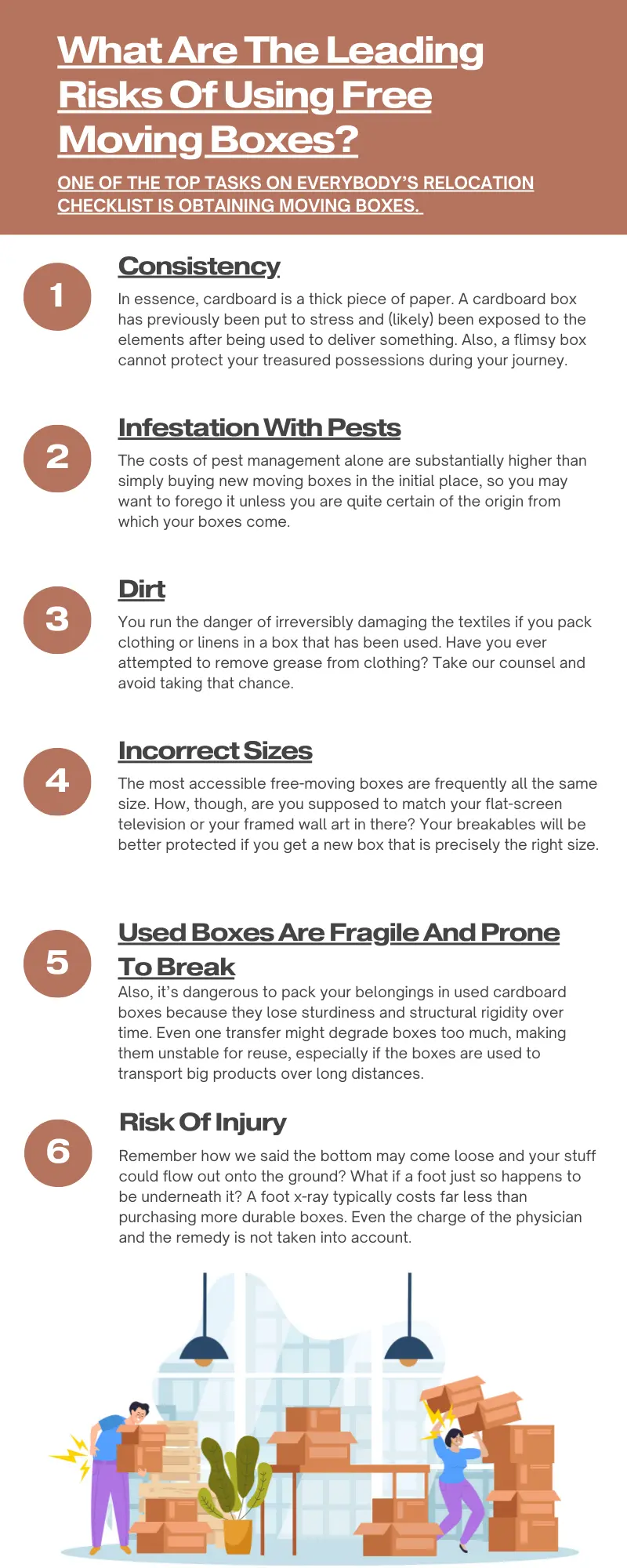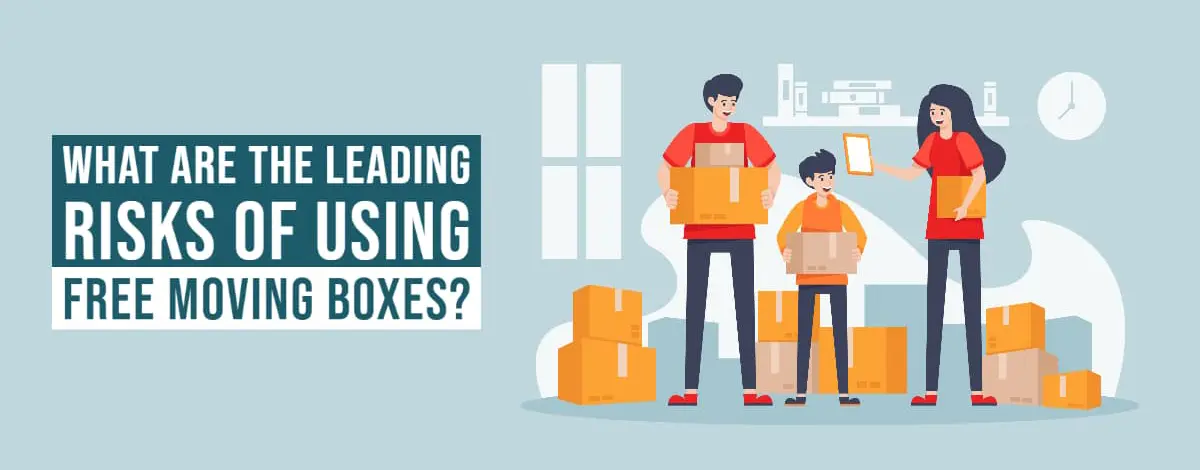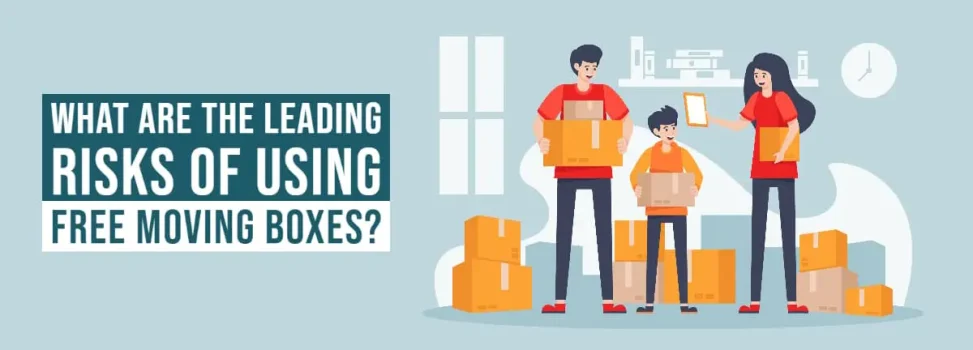One of the top tasks on everybody’s relocation checklist is obtaining moving boxes. And in the majority of households, that entails gathering as many free boxes as you can.
You can keep an eye out at the neighborhood grocery shop for discarded product boxes or ask Facebook friends who have recently relocated for assistance (let’s face it, everyone wants to get rid of those useless boxes!). But are second-hand boxes the best option?
Unfortunately, no.

To properly move, a lot of boxes are required. And shifting into your first apartment is included in that. Around 30 boxes are required for a modest relocation between studio units. A family of five would require more than 100 cartons of various sizes. Also, the caliber of those boxes has a significant impact on your relocation.
Here Are Some Compelling Arguments Against Using Free-Moving Boxes.
1. Consistency:
In essence, cardboard is a thick piece of paper. A cardboard box has previously been put to stress and (likely) been exposed to the elements after being used to deliver something. Also, a flimsy box cannot protect your treasured possessions during your journey.
Imagine this: The antique tea set from Great-Grandma is carefully put away and intricately bubble-wrapped. The bottom slips out when you pick up the bulky package (the same one last week that contained decaying veggies). Teacups from Great Grandma’s set is broken.
A new moving box easily defeats a used one in a head-to-head comparison.
2. Infestation with pests:
Your brand-new, sparkling house is infested with bed bugs.
The costs of pest management alone are substantially higher than simply buying new moving boxes in the initial place, so you may want to forego it unless you are quite certain of the origin from which your boxes come. Not to mention the potential for a bug infestation and the mental discomfort of an already difficult relocation. Your health isn’t worth it.
3. Dirt:
As if an infestation weren’t awful enough, used cardboard can accumulate oils, filth, and odors. (Just another way free-moving boxes could damage your belongings.)
You run the danger of irreversibly damaging the textiles if you pack clothing or linens in a box that has been used. Have you ever attempted to remove grease from clothing? Take our counsel and avoid taking that chance.
The worst you’ll have to do with brand-new boxes is thoroughly rinse your belongings when you reach your new house to get rid of some cardboard dirt.
4. Incorrect sizes:
Of course, packing large objects in little boxes is not a good idea, and if your boxes are too large, your items may roll around and shatter. The effort (and cash!) you will invest trying to protect your belongings with newsprint or bubble wrap should also be considered. You could save time by trying to put the goods in a box that was the proper size.
The most accessible free-moving boxes are frequently all the same size. How, though, are you supposed to match your flat-screen television or your framed wall art in there? Your breakables will be better protected if you get a new box that is precisely the right size.
5. Used boxes are fragile and prone to break:
Also, it’s dangerous to pack your belongings in used cardboard boxes because they lose sturdiness and structural rigidity over time. Even one transfer might degrade boxes too much, making them unstable for reuse, especially if the boxes are used to transport big products over long distances.
All free-moving boxes have likely already been used, thus it’s reasonable to presume that they have already suffered damage compared to their initial state. Due to the enormous weight of the content, ancient moving boxes with weak cardboard quality may easily crack.
Three things could occur if the bottom of a weak box of cracks in the midpoint of a relocation:
- Any delicate or fragile goods that are damaged when they fall on the ground;
- Any type of floor damage, including holes or scrapes in wood flooring or cracks on tiled floors;
- Personal damage occurs when a large object falls directly onto your feet or toes out of a used cardboard box.
- It’s rather obvious: old moving boxes are inherently weaker than brand-new ones.
6. Risk of Injury:
Remember how we said the bottom may come loose and your stuff could flow out onto the ground? What if a foot just so happens to be underneath it? A foot x-ray typically costs far less than purchasing more durable boxes. Even the charge of the physician and the remedy is not taken into account.
At that moment, are those free boxes still worthwhile? Most likely not.
How to Make Responsible Use of Free Moving Boxes?
What does it matter if you receive used boxes if you have a reuse and recycle mindset? How may those worn-out cartons be used?
Bring only lightweight, durable stuff. Use the boxes for your linens, clothing, and other light stuff if your source can be believed, and they are clean. Don’t fill them with bulky, delicate, or pricey objects.
Redesign as gift tags. If I’ve ever seen any financial advice, that is! For a cute, rustic aesthetic, cut small cardboard pieces into tag shapes and attach some string to a present.
Artisanal work. A family? If so, you already know that a large cardboard box makes the best toy! Ensure that everything is spotless and that the kids will not interfere with your move. They will be in their “spaceship” and out of reach.
Recyclable is cardboard. You’ll feed your compost, and your lovely new garden at your new home will be fed in turn.
Prevent weed growth. Experienced gardeners concur that a layer of cardboard is the best weed shield for a garden. It is not just degradable (see above) but also breathable.
Ways To Reduce The Hazards Associated With Using Unpaid Cardboard Boxes:
As you can see, there are some hazards associated with choosing free-moving boxes over brand-new ones. Even so, with caution and little risk to your health or expensive possessions, you should be able to significantly reduce your packing costs.
Here are some precautions to take when utilizing free packing supplies:
- Cautiously investigate the cardboard boxes you’re about to take for free.
- Verify that every cardboard box you agree to accept is spotless, particularly on the inside.
- Regardless of how minor it may initially seem, Dismiss any boxes that have prior damage. Protecting comes before making a few pennies.
- Each used box should have its bottom and sides folded for extra security. Employ a minimum of two rounds of premium packing tape.
- Fill the used boxes with enough padding, such as sheets of bubble wrap, handfuls of wrapping paper, or wrinkled newspaper.
- Don’t make used boxes overly heavy; instead, maintain them within a suitable weight range.
- When packing delicate possessions that you don’t want to see broken into bits, invest in brand-new moving boxes.
Given the expense of a move, we are aware that using free moving boxes can be enticing. Sadly, purchasing secondhand boxes may end up costing you more money overall than if you had simply purchased new ones initially.
On the lookout for a greener choice? For a strong and environmentally friendly relocation, you can purchase plastic moving boxes.
Frequently Asked Questions
Use fresh boxes.
Your best option is to purchase new moving boxes, but if you must reuse a box, just do so once before throwing it away. The boxes might become useless in some way if used more than once. Make a mound after taking them apart and putting them away.
Combine 1/2 cup of vinegar and 1/2 cup of baking soda in a spraying container, and after it has imploded out, add warm water to get rid of light stains from your cardboard boxes. Spread it on the discolored areas, and then wipe the stain with an absorbent cloth.
The likelihood of an old box breaking during your move is higher when you pack it. Inadvertent harm to valuables and other possessions may result from this.
In the majority of situations, single-walled or movable boxes are suitable for shipping.


